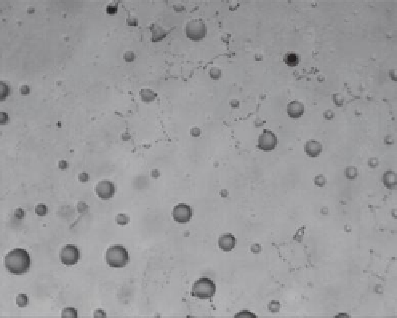Environmental Engineering Reference
In-Depth Information
where
x
is the length of the path of the mobile species in the material and
D
is the diffusion
coeficient. The diffusion coeficient of anions in hydrogels used for water remediation is
on the order of 10
−5
cm
2
/s [121]. Therefore, the time for mass transport in different materi-
als will depend on the thickness of the porous layer.
As can be seen in Table 2.1, a cube (each side = 1 cm) of nanoporous hydrogel will take
500 s (8.3 min) to be loaded with a soluble species by diffusion. On the other hand, a
mi croparticle (
d
= 25 μm) will take a negligible time (<1 s) to be loaded. However, nanopar-
ticles and microparticles are less useful because the handling of dispersions is complex
and some particles could be leaked to the environment. To avoid that, the SbS assembly
could be used (Figure 2.8) to produce surfaces containing small particles. It should be
borne in mind that the surface does not need to be planar. If nanoparticles need to be
assembled, a solid with pores of micron diameter can be used as surface.
An alternative way to produce fast transport materials without particles involves fabri-
cation of a macroporous hydrogel where the polymer walls around macropores have small
dimensions (e.g., 10 μm). The macroporous hydrogel was made using microscale templates
such as
in situ
produced ice crystals (Scheme 2.6a) [122] or
in situ
produced gas bubbles
(Scheme 2.6b).
The SEM micrographs of the gels, taken in low vacuum conditions (Figure 2.9), show
long macropores produced by the templating effect of the ice crystals (Figure 2.9a) or
TABLE 2.1
Time Response for Water Swelling of Different Hydrogel
Structures
Characteristic Size
(μm)
Form of Hydrogel
Transport Time (s)
Nanoporous monolith
1000
500
Microparticle
25
0.310
Nanoparticle
0.2
0.00002
Thin ilm
1.5
0.001125
Macroporous monolith
10
0.05
100 µm
FIGURE 2.8
Optical micrograph of hydrogel microparticles (made as described in Figure 2.6) self-assembled (SbS) onto a
glass surface. Microparticles are dyed with methylene blue.





